Cicada Damage to Blueberry Crop
go.ncsu.edu/readext?1007281
en Español / em Português
El inglés es el idioma de control de esta página. En la medida en que haya algún conflicto entre la traducción al inglés y la traducción, el inglés prevalece.
Al hacer clic en el enlace de traducción se activa un servicio de traducción gratuito para convertir la página al español. Al igual que con cualquier traducción por Internet, la conversión no es sensible al contexto y puede que no traduzca el texto en su significado original. NC State Extension no garantiza la exactitud del texto traducido. Por favor, tenga en cuenta que algunas aplicaciones y/o servicios pueden no funcionar como se espera cuando se traducen.
Português
Inglês é o idioma de controle desta página. Na medida que haja algum conflito entre o texto original em Inglês e a tradução, o Inglês prevalece.
Ao clicar no link de tradução, um serviço gratuito de tradução será ativado para converter a página para o Português. Como em qualquer tradução pela internet, a conversão não é sensivel ao contexto e pode não ocorrer a tradução para o significado orginal. O serviço de Extensão da Carolina do Norte (NC State Extension) não garante a exatidão do texto traduzido. Por favor, observe que algumas funções ou serviços podem não funcionar como esperado após a tradução.
English
English is the controlling language of this page. To the extent there is any conflict between the English text and the translation, English controls.
Clicking on the translation link activates a free translation service to convert the page to Spanish. As with any Internet translation, the conversion is not context-sensitive and may not translate the text to its original meaning. NC State Extension does not guarantee the accuracy of the translated text. Please note that some applications and/or services may not function as expected when translated.
Collapse ▲It seems we are finally on the other side of the “cicada invasion” which of course was not an invasion at all but did seem to be the talk of the town for the month of May in Pittsboro and other parts of the county!
Back in mid-April I wrote an article about the (then) looming emergence of the 13-year cicadas known as Brood XIX, and discussed whether farmers and gardeners should be worried about them damaging their crops. I advised netting any newly planted young trees because they could be significantly damaged if cicadas targeted the central leaders or other main branches for their egg-laying activity. Cicadas also lay eggs at the tips of the branches of mature trees (where the branches have a small diameter); the tip of the branch eventually “flags” as the leaves turn brown and the branch droops and eventually falls off (this does not harm a mature tree).
I spotted my first Brood XIX cicada on April 20 and by the end of April they seemed to be everywhere around Pittsboro. I remember giving tours of my Pollinator Garden in May and practically having to yell at times to be heard over the chorus of the male cicadas!
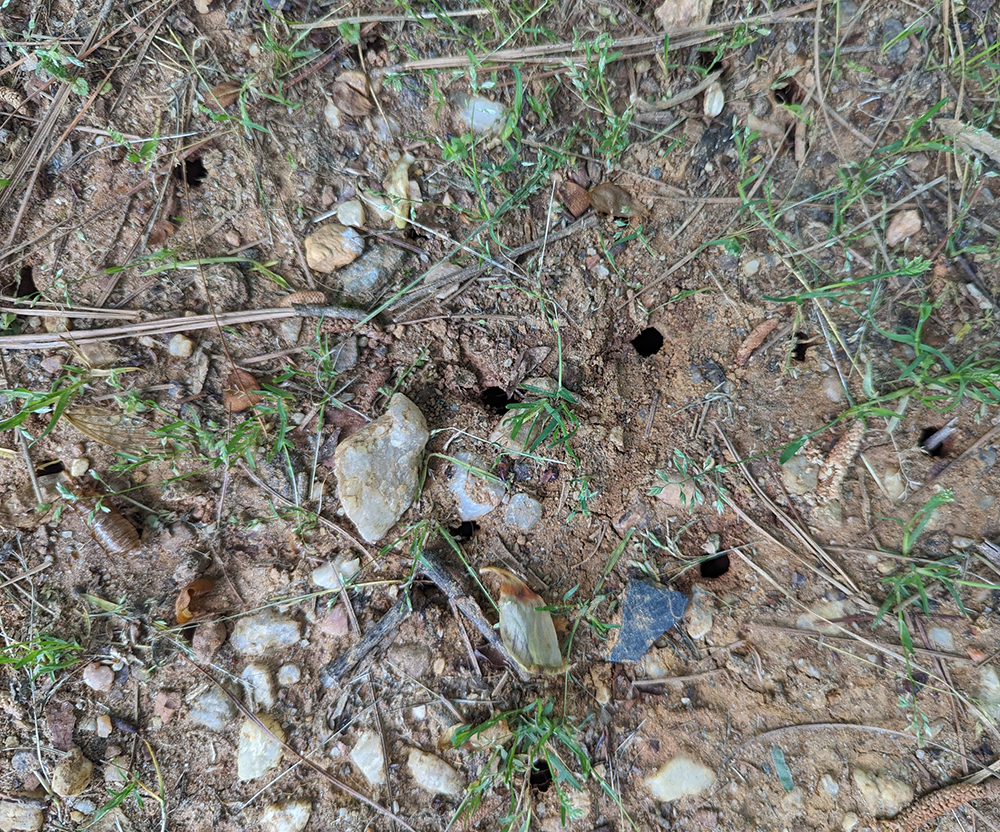
Exit holes where cicada nymphs emerged from the ground in late April. These exit holes are about 1/2 inch in diameter. Cicadas emerge when the soil temperature reaches approximately 64°F at a depth of 7-8 inches. Photo by Debbie Roos.

Brood XIX periodical cicada on bluestar in the pollinator garden. Cicada mania took hold as their numbers increased by the end of April and everyone enjoyed posting photos on social media of their latest cicada sightings! Photo by Debbie Roos.
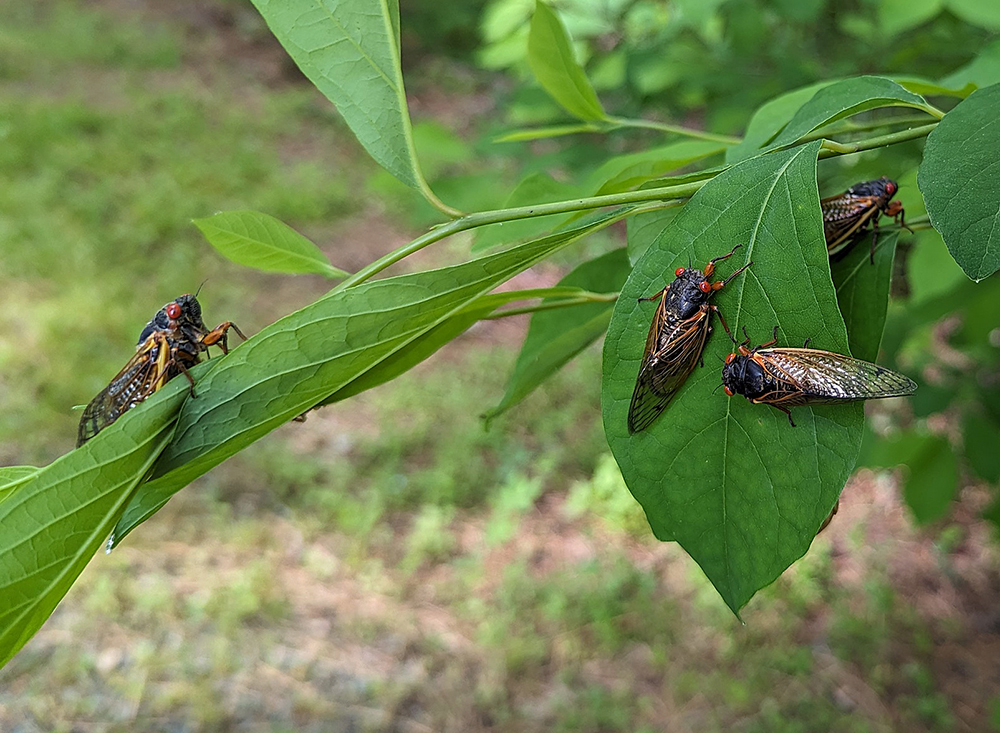
Recently emerged cicadas on a shrub in late April. These have already completed their final molt to adulthood. It was not uncommon to see trees and shrubs covered with dozens of cicadas and shed exoskeletons just after peak emergence in late April-early May. Photo by Debbie Roos.
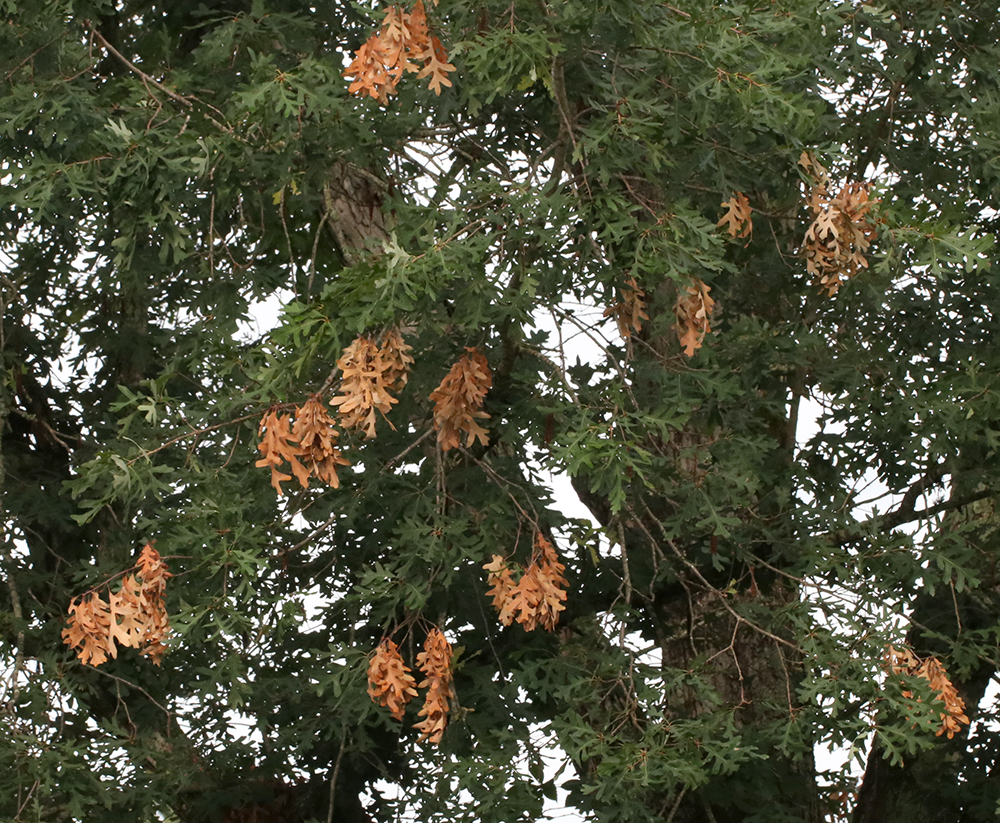
A few weeks after the cicadas emerged I started noticing the damage from their egg-laying activity. This large oak tree is showing “flagging” damage caused by cicada egg-laying activity on the tips of its branches. The egg-laying causes the tips of the branches to wilt and die but doesn’t cause serious harm to a mature tree. Photo by Debbie Roos.
In late May I was contacted by a local pick-your-own blueberry grower who was seeing extensive damage from cicadas on his blueberry bushes and wasn’t sure what to do about it. He estimated close to 100% of the bushes had some level of damage. I visited the farm to take a look and was rather surprised at how thorough the cicadas had been about going up up and down each row of blueberry bushes! Some bushes had one or two branches damaged and broken while other had multiple branches broken after being weakened from the cicadas’ egg-laying activity.

Cicada egg-laying on blueberry branches causes the branches to break. Any berries on that branch are lost. Photo by Debbie Roos.

Periodical cicada laying eggs on a buttonbush stem. Cicadas choose woody plant stems that are about the diameter of a pencil and use their sharp saw-like ovipositor to insert eggs into the stem. Photo by Debbie Roos.

Cicada eggnests on a blueberry bush stem. The cicada will lay as many as 20 eggs in each nest, and one female can lay up to 600 eggs in her lifetime. Photo by Debbie Roos.

Cicada eggnests on a blueberry bush stem. Photo by Debbie Roos.

Cicada eggnests on a blueberry bush stem. Photo by Debbie Roos.

The cicada eggnests weaken the stem and can cause it to break. Photo by Debbie Roos.
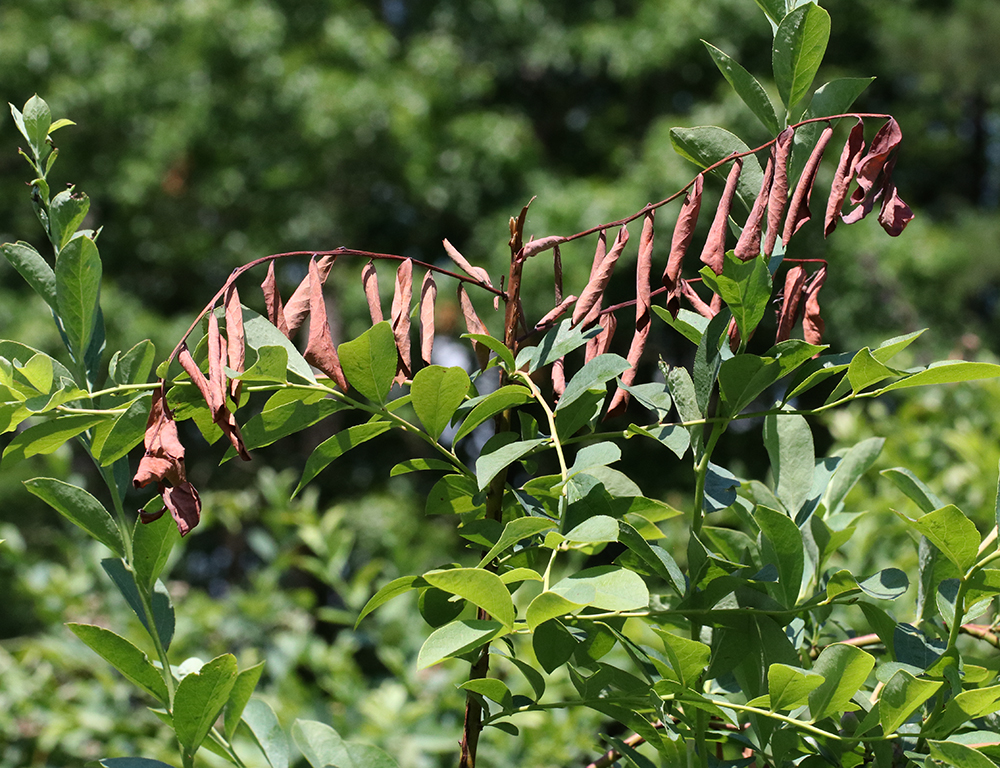
The top of this blueberry bush stem has already broken off due to cicada damage and the side branches have died from cicada egg-laying. Photo by Debbie Roos.

Cicada damage on blueberry bush. Photo by Debbie Roos.

Cicada damage on blueberry bush. Photo by Debbie Roos.

Cicada damage on blueberry bush. Photo by Debbie Roos.
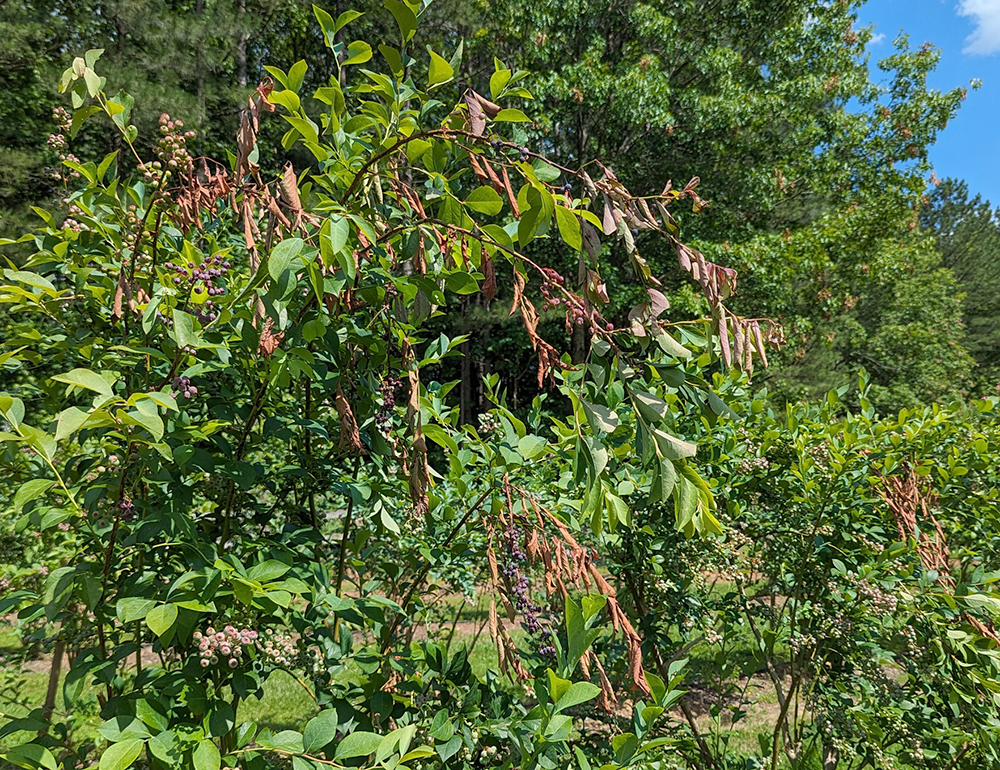
Cicada damage on blueberry bush. Photo by Debbie Roos.

Cicada damage on blueberry bush. Photo by Debbie Roos.
What To Do If Your Blueberries Have Been Damaged By Cicadas
Since blueberries are a multistemmed bush they will not be seriously harmed by cicadas. NC State University Blueberry Extension Horticulturist and Plant Pathologist Bill Cline recommends pruning out any damaged stems as soon as possible to prevent fungal wound pathogens like blueberry stem blight from infecting damaged stems. Prune now so that the bushes have time to re-grow new shoots and form flower buds for the 2025 crop. Pruning should be done before July 1 to give the bush time to regrow.
For more information:
Should Farmers & Gardeners Worry About the Upcoming Cicada Emergence? – NC State Extension
The Cicadas Are Coming! Fear Not Though – NC State Extension
Periodical Cicadas in the Landscape – NC State Extension
Periodical Cicada Information Pages – University of Connecticut
General Periodical Cicada Information – University of Connecticut


